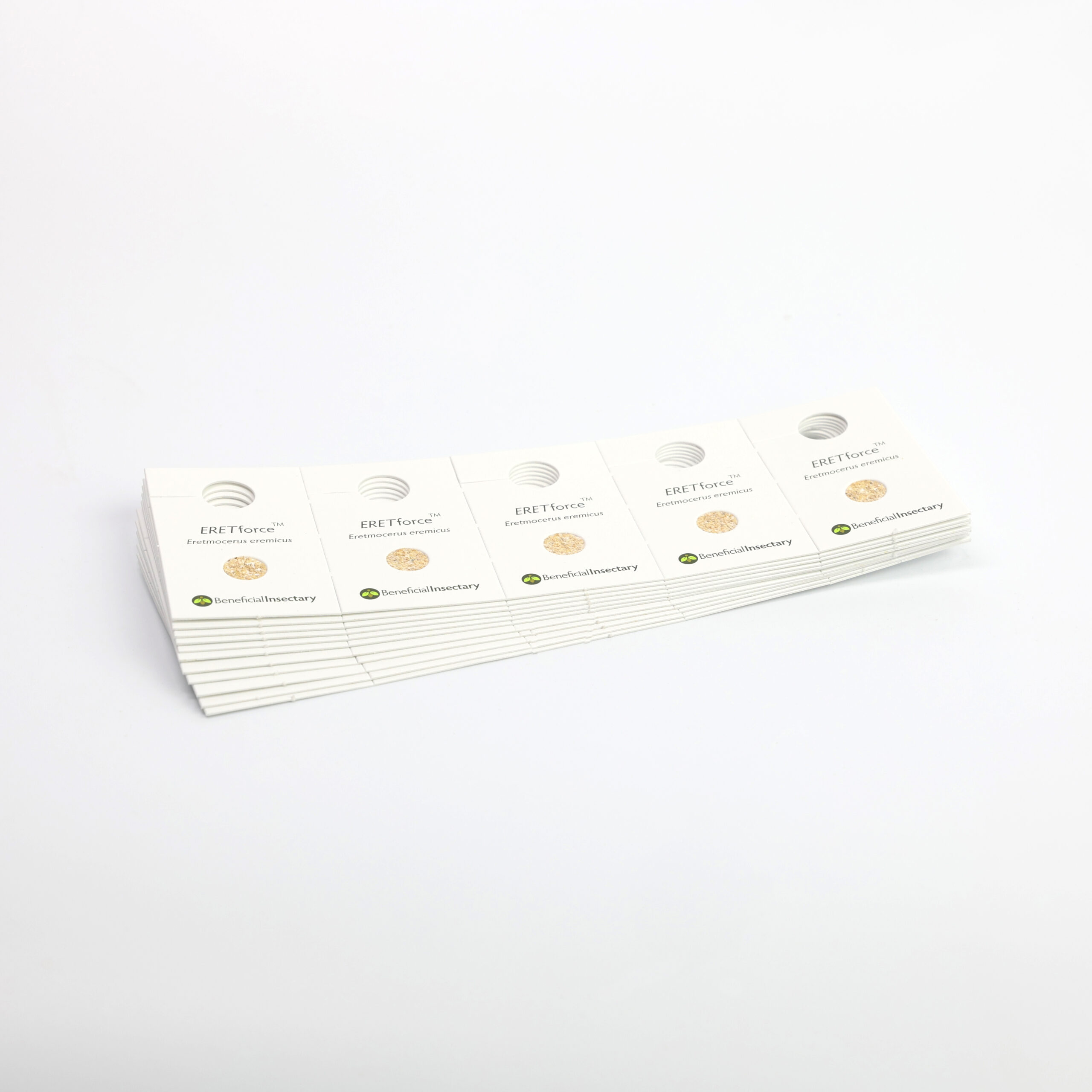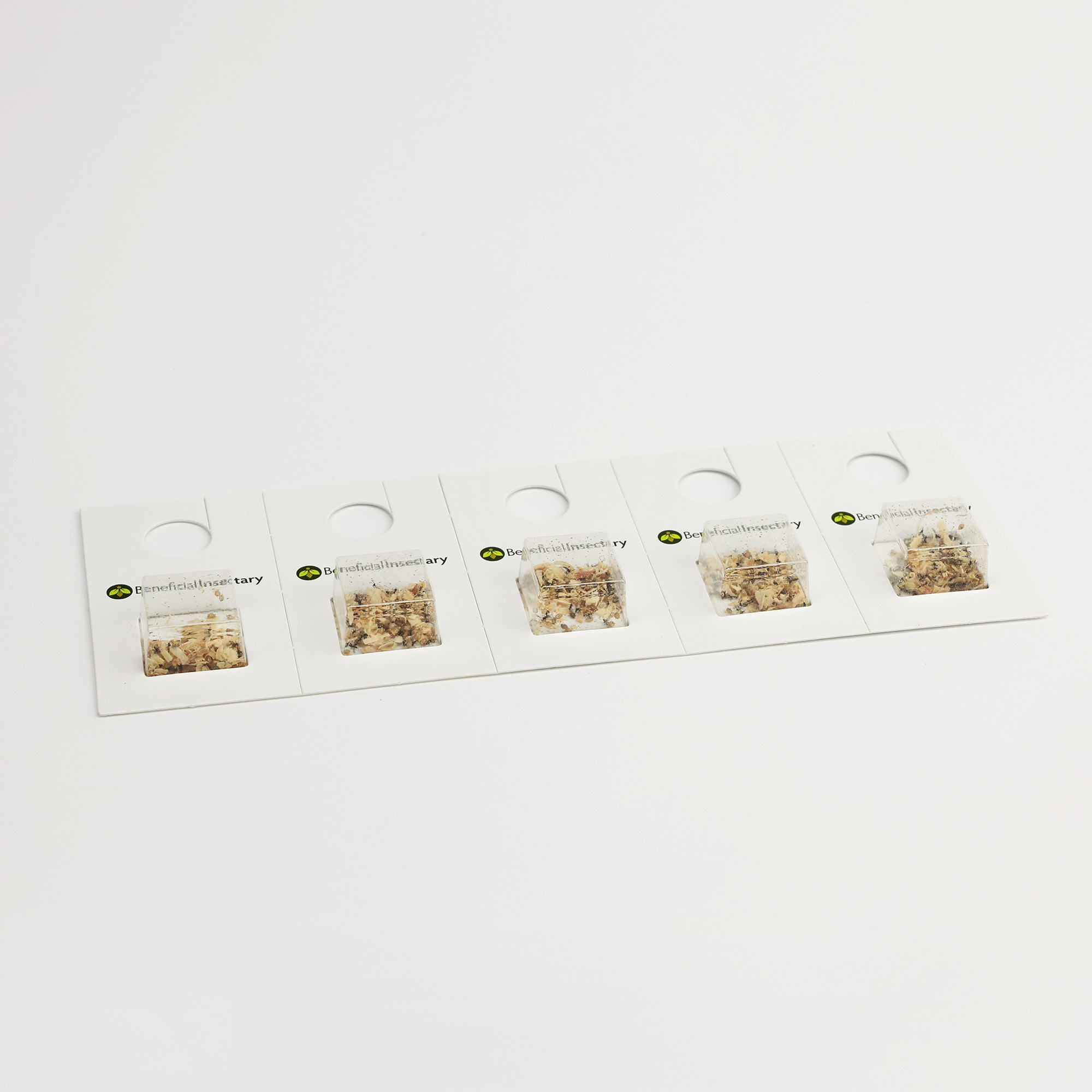ERETforce™
ERETforce™
A parasitic wasp which is helpful in the control of whitefly species.
Eretmocerus eremicus
Tobacco Whitefly (Bemesia tabaci)
Other Whitefly spp.
Vegetable Crops
Soft Fruits
Ornamental Crops
Hemp/Cannabis
Greenhouses
Indoor facilities
Field and row crops
Interiorscapes
Gardens


These organisms are specialist parasites that lay eggs inside developing sedentary whitefly nymphs.
Eretmocerus can target different whitefly species, but shows a preference towards 2nd instar nymphs.
Eretmocerus is most often used to combat Silverleaf whitefly (Bemesia tabaci).
Should ideally operate in a window of 68-77 °F and relative humidity of 70% or less.
Do not cold store. It is best to apply parasitic wasps as soon as possible upon receipt. If parasites storage is unavoidable, keep between 45- 50 ºF in the dark, up to 18 hours after receipt.
Cards (with pupae)
Release wasp pupae on cards in the early to late hours of the day after receipt. If this is not possible, avoid hot/dry times for release. After receiving the product, place the strips of cards in a cool dark space until the time of release. This allows wasps to maximize their remaining development time. Remove strips of cards from their container and gently fold along the perforations repeatedly; tearing cards may cause wasp pupae to fall off. Place cards within the canopy, taking mind to protect them from sun and water exposure in an even distribution throughout the crop or near preferred hosts by the pest. Place cards in shaded areas of the canopy, and leave undisturbed for 21 days to ensure emergence.
Some growers find it helpful to calculate how many individual cards are going into a section, block of plants, or area and then distribute cards evenly throughout a crop. Other growers will take this a step further and make release stations out of a bamboo stake, a bread tie, and some kind of a lid (usually a pot or a cup) so that they can make releases in the same general area or move release stations to where hot spots are in the crop. A release station consists of a bread tie secured around the top quarter of a bamboo stake and is then folded back on itself to make a rudimentary hook. The pot or cup is then inverted and laid on the top of the bamboo stake, creating a basic lid. Cards are then hung off of the hook, and the cover provides enough shade for predators not to be cooked in the sun.
Blister Packs (with pupae)
Releases are done under the same guidelines as the cards above. The major difference is that instead of wasp pupae glued to a card, wasps are put inside a plastic semi-circle bubble with an open-end glued to a card. This card has a perforation between it and the bubble so that when broken, it allows wasps to move out of the plastic bubble and into the crop. This release strategy is more advantageous in crops that are being overhead watered since the blister bubble provides more protection from rain.
Often, parasitized whitefly nymphs will have a wound where the adult parasitoid’s ovipositor contacted it.
Parasitized whitefly nymphs can take 10-14 days to begin appearing. Take note of the parasitized whitefly nymphs on cards or blisters as they are received; this is also the easiest life cycle to scout in the crop.
Scouting for eretmocerus parasitoids requires looking closely inside whitefly nymphs for developing eretmocerus larvae.
Catching adult wasps on yellow sticky cards are not out of the ordinary. The use of sticky tape can often lead to mass trapping of parasitoids.
Adult wasps can move quite quickly and are capable of flight, making them difficult to observe while actively scouting whitefly populations.
Unparasitized whitefly nymph casing will have a T-shaped slit cut off where a whitefly adult emerged, where parasitoids will leave whitefly nymphs out of the submarine-style hole.
Yellow sticky cards can catch these adult wasps as they emerge; sticky card removal is ideal at the time of release.
Live-Product: Beneficial Insectary strives to guarantee the live delivery of the freshest organisms to our customers. We offer replacements or credits for any compromised shipments to our customers that report any issues or concerns within 24 hours. These issues or concerns must be relayed before releasing any organisms that are suspected of having viability issues. Please do not discard the product. You may be requested to return the shipment for further analysis.
Establishment of BCAs in Crop Settings: Many variables can negatively or positively impact BCA and pest populations in various crops we work with (pesticide applications, watering practices, improper storage methods, cultural/physical/mechanical controls, etc.). Some beneficial organisms require a steady pest presence as a food source to build their population. Others may require alternate food sources, such as pollen or nectar as an example. While other BCAs have specific photoperiod requirements for success. Due to these variables, we cannot guarantee the long- or short-term establishment of the BCAs we sell after the release of the organism(s). We will not offer refunds, discounts, or other credits on products that have already been released. Please adhere to our “Live-Product” disclosure.
Product RELEASE METHOD
PRODUCT SPECIFICATIONS
PRODUCT | PACKAGE SIZE Filler/Carrier | LIFE STAGES | PRODUCT CODE |
|---|---|---|---|
ERETforce™ – 5,000 | 50X100/Card | Pupae | EE5 |
ERETforce™ – 7,500 | 30X250/Blister Pack | Pupae | EE75BP |
ERETforce™ – 10,000 | 100X100/Card | Pupae | EE10 |
ERETforce™ – 10,000 | 30ml Vial (Loose) | Pupae | EE1L |
ERETforce™ – 15,000 | 150X100/Card | Pupae | EE15 |
ERETforce™ – 15,000 | 60X250/Blister Pack | Pupae | EE15KBP |
RELEASE RATES
CLASSIFICATION | RELEASE INFORMATION |
|---|---|
Low | 0.5 to 2 per 10 sq. ft. |
Medium | 5 to 20 per 10 sq. ft. |
Comments | Preventive releases may need to be made weekly instead of bi-weekly if the crop is a “whitefly magnet.” |

CANNABIS ALERT: Release rate suggestions on these pages are usually not sufficient for cannabis growers. For cannabis release rates contact us.
Life Cycle
EGG STAGE
- Eggs are laid under whitefly larvae or pupae
LARVAL & PUPA STAGES
- The wasp completes 3 larval stages within the host
- The wasp pupates within a light-brown case
ADULT STAGE
- The female adults are citron yellow, have green eyes with three red dots (the so-called ocelli or simple eyes) and have five antenna segments in total
- 0.8 mm Long
- The males are yellow brown, have three thickened antenna segments and are smaller than the females
